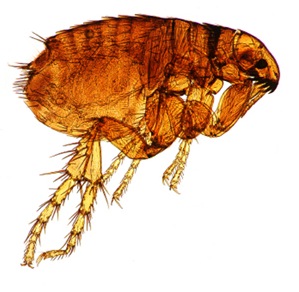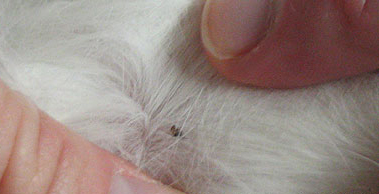How to deal with fleas
Posted on: Tuesday, September 18th, 2012Anyone who’s had a pet at some point has experienced fleas. While these nasty little parasites can be hard to avoid in the summer and fall months, there are ways to deal with them and prevent them from making you, and your pets miserable.

Flea Symptoms
Luckily, flea symptoms are easy to spot. If you’ve noticed any of the following, there’s a good chance your pet has fleas.
- Excessive scratching
- Pink, irritated skin, known as hot spots
- Biting/nibbling at the skin repeatedly in specific spots
- Loss of fur in certain areas
How to Check for Feas
Here are two useful techniques to check for fleas on your animal.
Use a flea comb
Run it through your animals fur a few times. Look in the tines of the comb for fleas, flea dirt (feces), and flea eggs. Seeing any or all of these, means your animal has fleas.
Use paper towels
Place a few paper towels under your animal and rub your fingers into his fur vigorously. Check for flea dirt on the paper towels.

This is what a flea looks like on a pet.
One Flea is No Big Deal Right?
Seeing a single flea, is an indication that there may be many more. Adult fleas on your animal represent only about 5% of the total population in your environment. The other 95% is the flea eggs, larvae, and pupae living in the rest of your home. Flea pupae can live dormant in their cocoons for up to 174 days. An adult flea can live on it’s host animal for about 3 months. If you want to rid your home of fleas completely, you need to destroy all life stages of the fleas in your home and on your pet.
Treating Your Pet for Fleas
Traditional Treatments:
Frontline Plus, Advantage, and Advantix
These once a month topical treatments are easy to use, and highly effective. They kill adult fleas on the pet, as well as contain insect growth regulators that kill flea eggs and larvae.
Capstar
A pill that starts killing adult fleas within the first 30 minutes of ingestion. It can be used on animals as young as 4 weeks and as small as two pounds. It can be used in conjunction with a topical flea preventative, such as Frontline or Advantage to control the whole lifecycle of fleas.
Natural Treatments:
Diatomaceous Earth
A non toxic flea remedy that can safely be used on both your animal and in your home. It is fossil shell flour that kills bugs including fleas by cutting into the exoskeleton and causing the bug to dehydrate.
Richard’s Organics Flea Shampoo and Spray
These products use natural ingredients such as peppermint, clove, cedar, cinnamon and rosemary oils to kill and repel fleas on dogs. They are safe to use around children. These products cannot be used on cats since these pets are sensitive to essential oils.
Flea Control Methods for the Home
Vacuuming
Vacuuming will allow you to collect the flea eggs, larvae, and adult fleas that are in your home. Be sure to empty your vacuum’s bag/bin outside immediately after vacuuming so the fleas are not able to jump out of the vacuum and continue to infest your home.
Flea bombs
Flea bombs spray a fine mist of insecticide throughout the area. It is only recommended for heavy infestations, as using a flea bomb will require you to leave your home with your pets for about 2 hours. The insecticides used will kill adult fleas and provide extended protection against flea eggs and larvae.
Sprays and Powders
These products allow you control to what areas get treated with insecticides such as the carpet, pet bedding, couch, etc. Upholstery sprays and powders require that the area be left for about an hour before allowing your pets, children, or yourself back in contact with the area.
Most pet owners deal with fleas at one time or another. Don’t feel discouraged if one type of treatment didn’t seem effective. To combat a flea infestation it takes a full on attack, treating your animal and your home. We hope this information helps you win the flea war!


